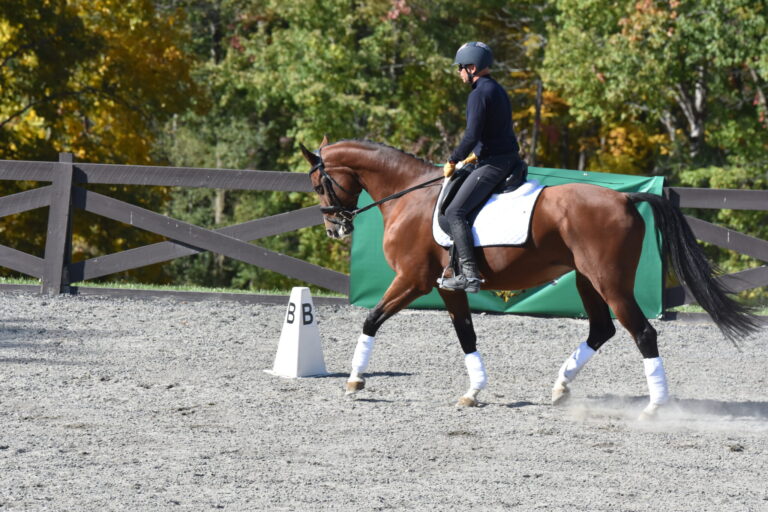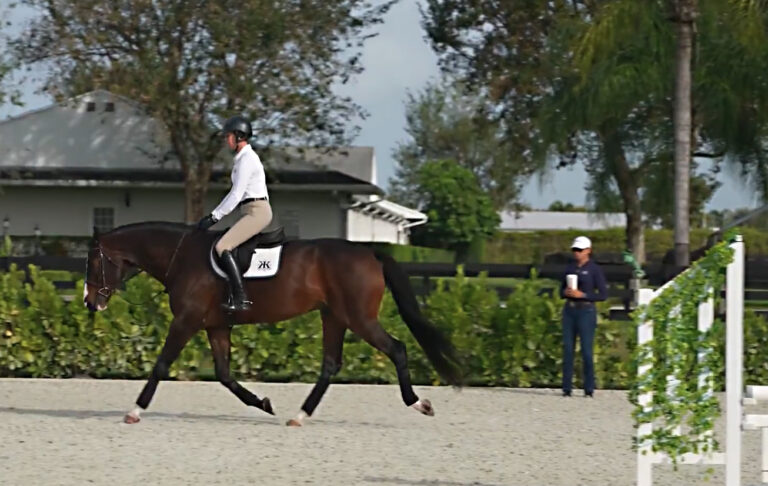The below photo is of Maureen Kline and her horse Doctini. Here is what Maureen had to say:
“As horse and rider, we’ve been together 7 months. I am 57 years young and have been riding again for two years after a 24-year hiatus. Doctini is an 8-year-old Trakehner mare trained up to Fourth Level. She’s recently back to work after three month’s rest recovering from founder.”

Looking at this picture my first impression was: What a well-matched pair! Maureen looks highly concentrated and motivated to ride as well as she possibly can, and her horse appears to be a well-trained, gentle schoolmaster. The horse and rider seem focused on their task and are very harmonious together.
Doctini is walking forward with a nice, long stride, stepping well under the rider’s seat. She appears to be an uphill-built horse with a well-muscled, round topline and demonstrates nice self-carriage with a light contact on the bit.
Releasing Tension for a Deeper Seat
I like how Maureen is sitting very upright with soft hands and keeping her leg long and heel down. However, it’s important for her to understand that good posture involves movement. For example, forcing her heels down can cause tension in her hips and lower back. Looking closely, you can see that her lower back is slightly hollowed and her seat could connect deeper to the saddle.
Riders must maintain supple ankles in order to release their hip joints. The horse’s movement should be
absorbed through supple hip joints and reflected in a springy ankle. To “shock absorb” the horse’s movement, a correct grounding of the foot in the stirrup is necessary.
A simple exercise can help riders feel the influence and connection of the pelvis position and stirrup control. Stand on the ground as if you were on a horse, with your legs slightly apart and your knees slightly bent. Then, jump up and down with little bounces. You will notice that you always land on the balls of your feet—the part of your feet that should rest on the stirrups. Now, try jumping and landing on your heels. The impact will feel immediately stiff. While riding, transfer the feeling of landing on the balls of your feet as you evenly distribute your weight across the base of the stirrups. This will help stabilize your upper body, create elasticity and suppleness in your seat and allow your heels to be springy shock absorbers. Simply becoming aware of this feeling can immensely improve your balance in the rising trot and your ability to sit the trot and canter.
Free Up Your Toes
Similar to how the ankles need to be supple and springy when putting weight in the stirrups, your toes also need to be free to wriggle around. Think of playing piano with your toes in the rhythm of the horse’s gaits, which can be surprisingly effective at relaxing the whole body. The toe muscles reach up behind the knee and connect into tendons and fascia in the hip, and “playing piano” with the toes can automatically release tension in the hips and improve upper-body balance. Practice maintaining this toe movement during transitions to help create a more forward and fluid ride. Every rider will react a little differently, so try the exercise several times to feel the effects on your (and your horse’s) body.
Another helpful visualization technique is to imagine bouncing a ballon the ground; you know that you can control the bounce by the direction of your hand meeting it. Similarly, your stirrups help with the rebound of the horse’s movement. To best do this, the stirrups should ideally be parallel to the ground. To enhance the cadence of the horse’s movement, it is very helpful to feel more weight on the front part of the stirrup base.
Evenly distributing weight across the balls of your feet in the stirrups will help ground your seat, and the more weight you put into the stirrups, the taller your upper body becomes. Stretching your legs down and growing tall at the same time demonstrates the concept of sitting deep and light on the horse. This grounding of the seat and legs helps decompress the lumbar spine, enabling the rider to sit tall without negative tension.
Adjusting the Rider’s Pelvis Position
With a better grounding to the stirrups, Maureen can then work on refining her pelvis position. The following exercise can be performed on a chair or a quiet horse (only at the walk at first) and will help correct her pelvis position without causing her to lean back with her shoulders. Take a scarf and sit on one end of it, pulling it lengthwise along your back and up over your head. With your pelvis, you want to hold the scarf down under your seat bones while your hand and upper body straighten up. This triggers the abdominal and core muscles to become active and rotates the pelvis into a more upright position, filling out the hollowness of the lower back.
On a quiet, safe horse, this exercise can help connect the seat in sitting trot and canter. To do this, you must be able to ride with your reins in one hand while pulling on the scarf with the other hand. You might be surprised just how quickly the scarf can be pulled out from under your seat. You will feel the need to deepen and connect your seat more to keep it in place. But even by practicing this exercise on a chair, the muscle memory and mental image will help you find a deeper connection in your seat while maintaining a light and upright upper body once you’re back in the saddle.
For Maureen, developing a deeper connection with her seat and more grounding to the stirrups will enhance her feel of the horse’s movement and enable her to ride with light and nearly invisible aids. These adjustments will help hone her skills and allow for more harmony with Doctini, so she and the mare can enjoy their journey through the levels together.
About Susanne von Dietze

Susanne von Dietze is a leader in equestrian biomechanics. A physiotherapist, licensed Trainer A instructor and judge for dressage and show jumping, she gives lectures and seminars throughout the world, including at the prestigious German Riding Academy in Warendorf. She is a native of Germany and now lives with her husband and three children in Israel, where she competes at the international level. She is the author of two books on the biomechanics of riding: Balance in Movement and Rider and Horse, Back to Back.
For more with Susanne von Dietze, click here.
You can also find more with von Dietze on Dressage Today here.
This article first appeared in the 2025 Spring issue of Practical Horseman.











